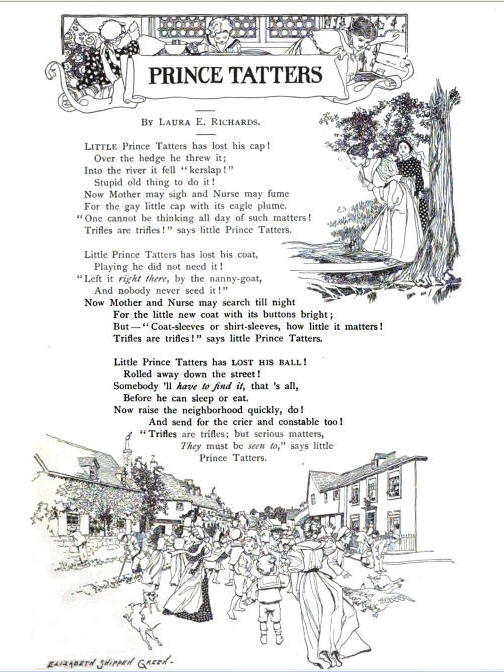
Several years ago, "Prince Tatters" was the subject of an online discussion conceived and coordinated by Sanjay Sircar, who later added an informative introduction, edited and published the results as "'Trifles are Trifles': A Symposium on Laura E. Richards's 'Prince Tatters', a Poem for Children" in Comparatistica: Annuario Italiano 13 (2004): 126-157 (the journal of the Italian Society of Comparative Literature). In addition to Sanjay Sircar, participants were Kathleen Chamberlain, Ann Dowker (mistakenly identified in the published article as of the "Department of Clinical Psychology" rather than the "Department of Experimental Psychology" at Oxford University), Donna Godoy, Martha Grenzeback, Linnea Hendrickson, Jackie Ogburn, Anne H. Paradise, Helen Schinske, Kathy Templeman, and myself.
At Dr. Sircar's suggestion and with his permission, I've posted the following supplementary materials: a brief introduction and additional commentary by Dr. Sircar incorporating several comments that were omitted from the published article; scans from several early editions of the work since part of the discussion concerned Prince Tatters's actual status; a series of discussion questions created by Dr. Sircar; and additional thoughts by him on the entire process.
Copies of the article can be ordered from Antonio Pagliai or via Polistampa's web page. (Although the webpage is in Italian, the article is not.)
The "Prince Tatters" article draws upon various critical schools to cover impressions of the status of verse for children with child and adult readers today; then, in relation to the poem, it considers tone, genre, school, period, author, ambiguously stylised/realistic representation of the child-protagonist, class, age, gender, the ideology of the nature of childhood presented, specific analogues, and technical felicities and infelicities.
The published symposium is a creative "rendition" of the things "said" in emails by contributors; not an exact or edited "transcript" of an actual set of real-life conversations. For some participants, certain questions and issues apparently were of little concern. I pushed some participants to come up with more responses on certain aspects, while "fishing" for things, partly in response to things the others had said, then tidied them up, as I brought together similar ideas from different people. This tidying of ideas is akin to one approach to phenomenological data analysis of focus group data, which involves "horizonalization of individual statements" and "creation of meaning units, transformation to clusters of meanings or themes that remove overlapping and repetitive statements, advancement of textural (the "what") and structural (the "how") descriptions, and description of the essence of participants’ experience."
One feature that was not noted in the discussion was that even in this day of "constructions" and "discourses" and a suspicion of appeals to an untheorised empirical "real life", participants went easily from literary images of childhood to their sense of what "real children" were like, from their own experience.
One academic who did not take part in the discussion but was asked for comment on the article noted that the adult participants' responses are a "curious blend" of professional adult expertise or focus combined with a "remembering of childhood" --- "what I did at school...I encountered a child who..." --- which is about an adult construction of the (literature of/image of) childhood through the lens of adult experience.
Laura E. Richards’s child-poetry
Sketches and Scraps. Boston: Estes and Lauriat, 1881.
The Hurdy Gurdy. Boston: Dana Estes, 1902 (includes "Prince Tatters").
In My Nursery. n.p.: Roberts Brothers, 1890; repr. Boston: Little,Brown and Company, 1919.
The Piccolo. Boston: Dana Estes and Company, 1906.
Tirra Lirra (collection from previous volumes and uncollected verse in journals). New York: Junior Literary Guild, 1932 (mistakenly ascribes 1902 copyright of Hurdy Gurdy to L. C. Page of Boston); reprinted Boston: Little, Brown and Company, 1955 (mentions 1902 Dana Estes copyright reverting to Richards 1930sff., contains "Prince Tatters").
Additional Sources
Alexander, Anne Stokes. Laura E. Richards: a Critical Biography. Ph.D. thesis, Columbia University, 1979.
Viguers, Ruth Hill. "Laura E. Richards". Horn Book, Vol. 32, 1956, pp. 87-97, 1963-177, 376-388, and 467-478 (most of these four issues devoted to the life and work of Richards).
See for useful background Victorian Poetry 16 (1978), ed. Ina Hark, special issue dedicated to nonsense, parody, and light verse.
The Illustrations: Aids to and Evasions of Interpretation?

Deidre Johnson noticed that Green is the only one to illustrate each
verse separately and that those drawings perhaps suggest an over-solicitous mother -- which may account for the perception that Prince Tatters rules the
household. Sanjay Sircar added that these are also the only
illustrations of the ones so far discovered which have Mother and Nurse
(in distinctively polka-dotted attire) in all three segments, thus
underscoring the unity of the three stanzas.
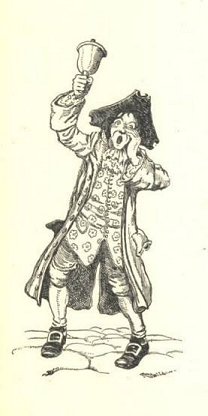 |
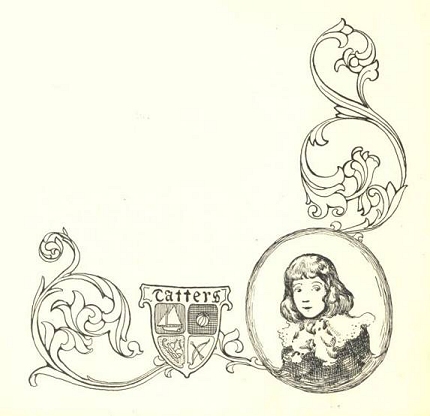 |
2. Illustrations by J. J. Mora from the first edition of Laura E. Richards, The Hurdy-Gurdy, (Boston: Dana Estes, 1902, pp. 40-41). (Click on image to see illustration in context.) The illustrations are unsigned, and no illustrator is mentioned on the title page, but "J. J. Mora" is the signature on some of the illustrations, which appear to be by the same hand (information from Maggie Libby, Special Collections, Colby College, 2005).
In relation to simply getting various illustrations as adjuncts to interpretation, it should be noted that "on the ground", one of the difficulties of studying (or just reading and appreciating) older, out-of-print work is sheer unavailability, and the obstacles raised by holding libraries which will not lend what they consider to be rare items, and that these work silently to direct discussion of children’s literature towards easily obtained contemporary work. This is the way that worthwhile literary heritage dies.
Assuming the poem had not appeared in a magazine before the 1902 book publication, the original illustrations are (a) a town crier with a large bell upraised in one hand, the other hand cupping his open mouth as he cries out and (b) from left to right, a circular floral appendage joined to a central coat of arms, in turn joined to a an oval-ish front-face "miniature"-like head-and-shoulders portrait of Prince Tatters with shoulder-length hair and lace (?) collar, with another similar floral decoration above the portrait. The entire set forms something like a right angle at the bottom left of the page. This is what was said.
Martha Grenzeback: These illustrations in The Hurdy-Gurdy are in a style standard for the era, I think --- not really remarkable.
The coat of arms in this original illustrator's first "interpretation" is in line with the teasing tone of the poem, which makes gentle fun of Tatters' imperious demands. Below the word "Tatters" in something approximating to Gothic script are four quarters depicting, respectively, a sailboat, a ball, a sled, and a bow and arrow, which keeps in tandem the boy's status as the spoiled darling of his family and the metaphor of "prince-dom" formally used to convey that status, which I feel is surely not that of a
"real" prince, but an "ordinary" boy.

Sanjay Sircar: We tend to assimilate "real prince" with "prince from the past", which ain't necessarily so, but might be a legitimate assumption in this context. Anyhow, note, however, that while the coat-of-arms with the toys on the quarterings of the Mora illustration leads in the direction of a stylised but "real" ordinary modern child, not a literal prince, the first illustration, that of the crier in eighteenth-century costume, might carry some weight for the opposite view --- Tatters as a "real prince" from "the past".
The illustration of Tatters himself is redolent of Reginald Birch’s image of Frances Hodgson Burnett’s Little Lord Fauntleroy (1886), which had a phenomenal impact on boys’ fashions. It has been said that Birch’s pictures were responsible for the later somewhat negative image of Little Lord Fauntleroy as overly saccharine. Be that as it may, boys were put into Little Lord Fauntleroy "costumes" till at least World War II, as "fancy dress".
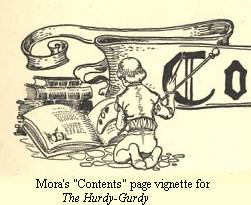
Hence, how do we interpret J.J. Mora’s image of Tatters? Is it that of an "aristocratic" boy from the past, redolent of a cavalier or an eighteenth-century boy? (Cf. Mora’s headpiece vignette to the "Contents" page which depicts the back of a boy with a "page-boy" haircut, coat, billowing shirt, and close-fitting nether garments, holding a palette and paintbrush [?], with a stylised, archaic feel to it, I think.) Or is it a late Victorian/early 1900's middle-class Little Lord Fauntleroy (or something allied to him), and as such of a boy both contemporaneous and ordinary (i.e. not a prince)? Do Mora's images refuse to come down on one side or the other, i.e. are they equivocal? Or are they deliberately contradictory, and to be interpreted to include both views?
Helen Schinske: Mrs. Hodgson Burnett was not always as original as we might take her to be. In relation to her Little Lord Fauntleroy, a similar costume was described by Mrs. Ewing in The Story of a Short Life (1882) a bit earlier. I don't think the dress (rather than "costume") is anachronistic in either writer -- simply generically "old-fashioned" in the sense that lots of dressy clothes for children are, without being actual period costumes. Anything velvet is going to bring to mind endless historical portraits, after all. Kate Greenaway took images of children in velvet and similar far enough to be anachronistic, but Birch didn't, I'd say; and Birch, I think, was going on a fashion that already existed, rather than popularizing a version of one past.
Nevertheless, I don't think there is anything that is supposed to be especially modern about the pictures of Tatters himself -- either in Mora or in Pogany. I think they're just redolent of something like the syncretic worlds of "fairy-tale countries" in modern children's literature, like Andrew Lang's burlesque Kunstmaerchen Prince Prigio. Mora's image of Prince Tatters's hair and collar could also (pace the eighteenth-century crier) be seen as "vaguely Renaissance" (much more vague than Pogany's "Good Queen Bess"-like Mother), because that's where the bulk of our fancy-dress images ultimately come from. And the toys on the quarterings are probably just a humorous take on that "vague, all purpose, aristocratic" past in combination with a more ordinary democratic present (just as Pogany's much more "glaring" mixture of periods is).
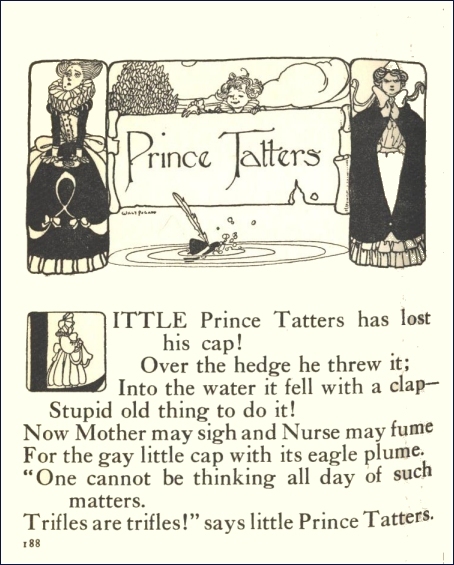
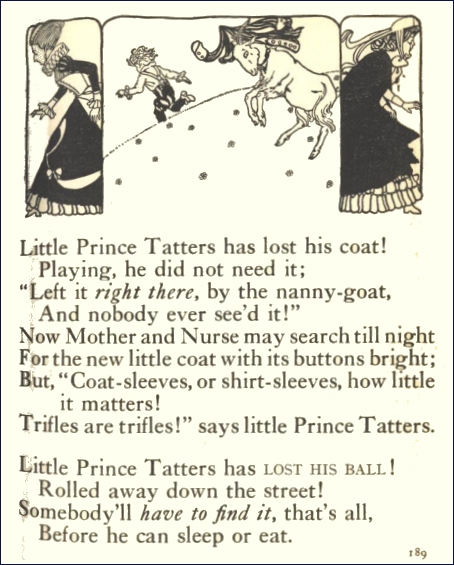
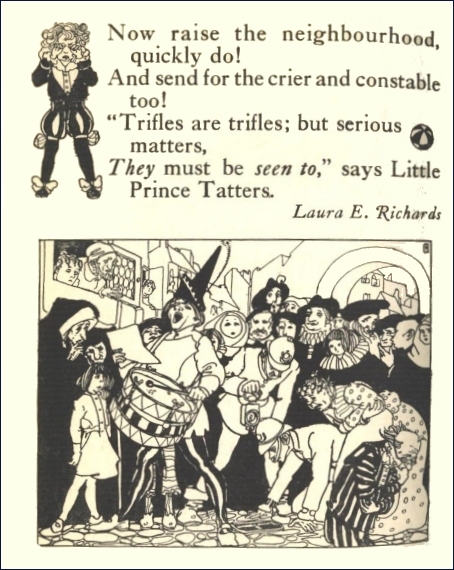
3. Illustration by Willy Pogány from M [Madalen] G. Edgar, sel. A Treasury of Verse for Little Children, (London: George G. Harrap & Co., 1923, pp. 188-190). These are the illustrations that the group worked with, and which are mentioned in the essay as deliberately mixing periods. They have been found only in British editions of the title.
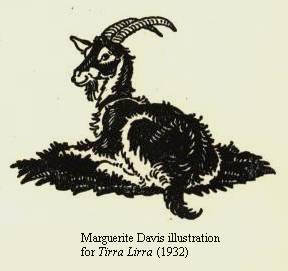
4. Illustration by Marguerite Davis and from Laura E. Richards, Tirra Lirra, incorporating some or all of the 1902 The Hurdy Gurdy which included "Tatters" (Boston: Little, Brown, and Company, 1932, p. 45). It is singularly unhelpful in signalling social status or locale.
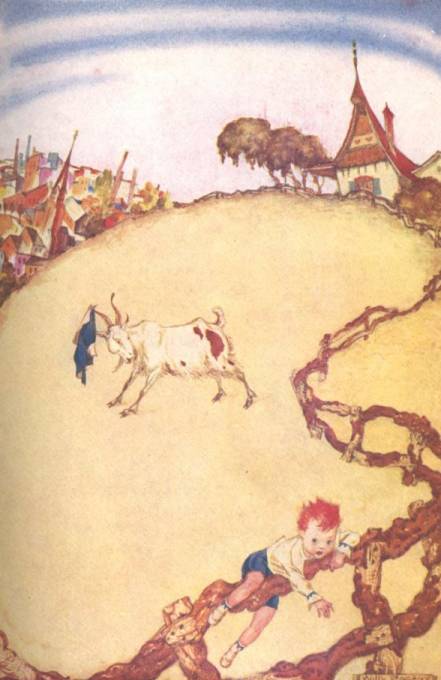
5. Another illustration by Willy Pogány from Grace Thompson Huffard, Laura Mae Carlisle, Helen Ferris sel. My Poetry Book (Chicago etc.: John C. Winston, 1934, 1952, p. [11]). Has clues for social status, but not locale. This is an ordinary modern little boy in a rural or semi-rural (?) setting. But what is the building in the background, the enclosure and the buildings to the left? Is this a realistic milieu or a stylised one, something like the world of an art-fairytale? And does the illustration contradict the poem implying that Tatters moved away from the nanny goat to play, and left his coat beside her, perhaps while there were others around, rather than running away from her as she tore up his coat, which is what the illustration seems to indicate?
Sanjay Sircar noted that the published discussion looked for additional analogues to "Prince Tatters"
but found no exact parallel; he later discovered a poem, "The Jolly Monarch," and a short story, "The Rocking Horse without Spots," in Warne's Top-All Book for Children (Frederick Warne & Co., Ltd, n.d.)
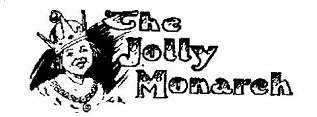
The King of Cadole was a light-hearted soul,
So full of good humour and wit.
When he met gloomy folk, he would tell them a joke
And endeavour to cheer them a bit.
He never stopped talking when he was out walking,
Except to break into a song.
If a pebble he found, lying loose on the ground,
He would playfully kick it along.
His favourite lark was to go after dark
And chalk things on people's front gates.
He loved tying pails on to little dogs' tails,
Or throwing hot pennies to Waits.
You may think that kings should not do such things
That they ought to be stately and cold;
But this monarch, so gay, I'd forgotten to say,
Was only eleven years old.
And you all must admit, although it is sad,
A boy of eleven will sometimes be bad.
. . . all the other spotted horses would look very superior and expensive, and the poor plain horse would get ever so dismal and creak unhappily.
"Oh, if only I had some spots!" he groaned. "Even one spot, quite a little spot, would be better than being all plain and un-rocking-horse-like as I am -- creak, creak."
Then one day the shop door bell went ping-ting-ting, and in walked a rather young Duke with his governess.
"I want a rocking horse," said the Duke.
"Yes, your grace," said the shopman, and all the spotted horses that were left preened themselves up and showed off their spots with awful conceit.
"Oh, I don't like these! said the Duke. "They are so usual. All rocking horses look liek that. I want something different" Then he caught sight of the plain horse tucked away in a corner.
"Ooooooh, lovely! he cried. "Why, there's a beautifully plain one over there without any spots at all! How original!"
It was the spotted horses' turn to cerak now, and th eplain horse was so surprised that he came all over dizzy and started to rock unsteadily.
"I'll have him," said the Duke, so the poor plain, unspotted, unordinary rocking horse was sent to the Castle and had a positively wonderful time in the Duke's nursery . . .
What is a "trifle" when it’s not a dessert and what is a "serious matter"? (perhaps asked even before reading).
What's more important to Prince Tatters? His hat and his coat or his ball? How do you know?"
What's more important to his mother and his nurse?
Which do you think is most important and why?
What do you think his mother and his nurse will do now?
Do you think he should have been made to get his cap and his coat? Or punished? Or left alone? Why?
How old do you think he is?
Is this an old or a new poem? Why?
Is the Prince a modern little boy or one in the long-ago past? Why?
Could he be both? If so, how?
Where does he live? Could he live in both a palace and a village? Why?
What is difference between the way he looks at the world and his mother and nurse do?
Is it a funny poem? Why?
Dr. Ann Dowker said that A. A. Milne’s "Have You Been a Good Girl, Jane?" appealed to her as a child. She had a friend whose parents were always asking her at the end of her visits to me if she'd been good (she usually had, Dr Dowker hastens to add) and Dr. Dowker thought this was fairly ridiculous for precisely the reasons that Jane gave in the poem. But Milne’s "Vespers", felt Dr. Dowker, is really a poem for adults about children, and not at all suitable for children. "Tatters", too, she thought, becomes more acceptable if seen as a poem for adults about children. Do you agree?
The symposium form of the article on "Tatters" raises questions about what research is and how it is done, who does it, and how it is presented. Orthodox literary criticism is based on the convention of a process involving application of a stated method (sometimes called "methodology", which is more properly an account of a method) by one brilliant mind, engaged in one single solitary act, which is then presented as one seamless linear utterance.
Research: Method, Process
With regard to research process and method, Nobel Prize-winning biologist P. B. Medawar once asked a question that became famous: whether the scientific paper is not a "fraud" because "it misrepresents the process of thought that accompanied or gave rise to the work that is described in the paper" (P. B. Medawar, "Is the scientific paper a fraud? in The Threat and the Glory: Reflections on Science and Scientists, New York: HarperCollins, 1963, p. 228). Psychotherapist Stephen Appel says, "In the process of developing a question (why am I getting migraines in this class?) into a line of inquiry and then into a piece of research, I have for many months alternated between floundering aimlessly and grabbing onto passing debris (personal experience of migraine, pedagogy, and psychotherapy, as well as reading in these literatures). That process has been one of intuitive leaps, serendipitous happenings, rational thought, as well as the creative activity of writing. There is no way to do research --- what we call ‘research methodologies’ are stories told after the fact to try to make rational a substantially irrational process. I have found that conducting research is a bit like going for a swim: floating, getting out of one's depth, diving below, treading water, swimming strongly. This is not like swimming in a river that has a source, a course, and a mouth: hypothesis, experimentation, results. Rather, it is like swimming in a large pool. There is no beginning and end, just water and endless shoreline. One gets in, moves around in the water, and after a while one gets out. I do so now with a final aphorism à la Winnicott: There is no such thing as a research method" (italics added; Stephen Appel, "Notes on the Psychosomatic Element of Migraine", from Forum: The Journal of the New Zealand Association of Psychotherapists, 5: 3, 1998, pp. 209-218, and also as a chapter in S. Appel ed., Psychoanalysis and Pedagogy, Wes[t]port, Conn. and London: Bergin & Garvey, 1999). Appel alludes to D. W. Winnicott’s famous phrase from 1952, "There is no such thing as a baby". Winnicott himself said of his "methodology": "I shall not first give an historical survey and show the development of my ideas from the theories of others, because my mind does not work that way. What happens is that I gather this and that, here and there, settle down to clinical experience, form my own theories and then, last of all, interest myself in looking to see where I stole what. Perhaps this is as good a method as any" (D. W. Winnicott, "Primitive emotional development" [1945], in Through Paediatrics to Psychoanalysis. New York: Basic Books, 1958, p. 145).
Are these comments not true for literary research as well? We often discover as we go along, not always by the application of a method, or in logical sequence.
Research: One Mind or Many, Whose Minds?
And we also often, even perhaps usually, discover by running our thoughts by our colleagues and taking in their responses to us as we go. It is a rare mind that works entirely alone from the beginning of an interest in a particular work to the end in an essay on it in print. Doing literary criticism, as anyone knows who has asked for advice on written work from peers, is much more of a collaborative process than traditional literary-critical essays admit. Orthodox research does take for granted (though it does not stress) that at the very least anonymous referees and magisterial gate-keeping editors, and scholarly predecessors (and contemporary colleagues) have contributed to the result. When one critic quotes another, building on them, in agreement or disagreement, that critic "answers" the other too. Hence, the resulting "citation networks" perhaps imply not only incremental knowledge building, but something like a diachronic "conversation" as well (particularly if someone that critic quotes then quotes him). But either such an "answer" is not responded to, or there are long gaps between utterance and response, and they occur in different places. In symposiums the pace is much quicker, and utterance and response appear at the same time in the same place.
The symposium form which draws on several interlocutors foregrounds the fact that our thoughts build on those of our colleagues. Of course, all voices are not equally polished or literate or interesting and every utterance is not equal to every other utterance or claim. Nevertheless, dialogues (e.g. in psychology, R. Langs and H. Searles, Intrapsychic and Interpersonal Dimensions of Treatment: A Clinical Dialogue, 1980) can present the delights of contrasting minds and styles in juxtaposition. With two in a conversation there probably needs to be no final putter-together; with more, there probably needs to be an arbiter, even if no final "right" answer is provided.
Email has let me gather together some academics and some interested readers outside the academy. Thus I have gathered something more like a "reading group" than an "academic group", since most "reading group members" comprise an educated group of readers, even if not professional ones. The reading group engages in something like a mass activity, and there is a chasm between the huge numbers of folk who participate in reading groups and those who work professionally with the canons of literature and produce criticism.
Academic segmentation-by-area-of-literary-specialisation means that each such area has undergone its own upwardly mobile period of jargonisation. In such a jargon-ridden world of literary criticism, the deceptive ambiguities that lurk in ordinary language are adduced as justification for that jargon (see James Miller, "Is Bad Writing Necessary?", and more generally Mark Bauerlein, "Bad Writing's Back" and the items it cites). Regardless of the distinctions between necessarily-difficult / clumsily-unclear / needlessly-pretentiously - deliberately-obscure - bad-writings, and regardless of the putative necessity to express difficult thoughts and concepts in difficult words and syntax, simple (even simple-minded?) thoughts such as ours on elementary matters (regarding elementary texts) such as those of which we speak need only simple words sans any post-structuralist stylistic ornamentation or the plumage of postmodernism; and surely such things sometimes and in some contexts have some modest, limited, value of their own, for some people, still? Anyhow, we must work within what are for us "the limits of the possible," to adapt economic historian Fernand Braudel's phrase, and of what we cannot speak, thereof we must remain silent. And for us, the academic area of "children's literature" (not a "discipline" in itself, I would think, though I have seen this word used for it) sometimes gathers together interested parties in literary studies, librarianship and teacher-education (though perhaps actually interested in different texts, approaches and questions, starting from different assumptions and working towards different ends). Perhaps the diverse composition of this audience (along with people who love some of the things they have read, as well as -- who knows? -- some children) might be an advantage to those of us whose intellectual and educational limitations mean we can neither think nor write "post"-ly. We hope that some members of such an audience might sometimes find our simplicity and clarity (and our basic thoughts and language) of a little marginal use.
Does rendering the conclusions of a reading group make the resulting piece any the less valuable? An academic who did not take part in the discussion said: And how would this "private experiment in the process of doing literary criticism" sit with the rarefied circles in which "lit.-crit." is conventionally performed --- a mile away from the democratic, chatty model of exchange to find common meanings that is offered here? What might this "experiment" have to say about how texts are collectively read that casts new light on the techniques of "lit.-crit." as practised in the academy, through journals etc.? Does an educated reading group usefully counterpoint formal processes of public literary criticism? What are results of the democratising of the process of doing "lit.-crit." when the journals, peer review etc. are removed, at least temporarily? Does the symposium form hold out at least a potentially oppositional model, akin to the ways in which most people do things (including teachers and school librarians), counterpoised to how normative "lit.-crit." is done and comes to be presented?
Nancy Chambers of Signal said that she was not enamoured of academic apparatus, had tried for years to arouse interest in collaborative reviewing, had done so in constructing joint reviews from separate reports on books in annual surveys in the 1980s, and had spoken on this sort of collaboration in recent conferences but aroused no interest. She also said that guidelines on practice should be formulated (e.g., as Jackie Ogburn suggested, each participant should send in a signed note assigning all rights for their contribution to the one who conceived of it; and she sent in a standard form of words to be used). Professor Peter Hunt said that he was very interested in the "Tatters" symposium, not least because it's an example of the sort of interactive criticism he would advocate himself.
In relation to children’s literature, Helen Schinske pointed to the presentation of actual symposia in, for example, Innocence and Experience : Essays and Conversations on Children's Literature, (comp. and ed. by Barbara Harrison and Gregory Maguire from programs presented at Simmons College Center for the Study of Children's Literature, New York : Lothrop, Lee & Shepard, 1987).
Research: Presentation
Appel also says that "When a story is too neat in construction, too smooth in the telling, we may suspect over-intellectualization." The surface tidiness of a piece of literary criticism disguises the untidiness of the process by which it emerged.
The symposium form, fictive or real, is age-old (Plato, Dryden, Wilde). The fictive symposium form, which is in the dialogue form but is written by one mind, indicates the bittiness of our thoughts, and how we conduct internal dialogues with ourselves as we think. It is not necessarily just an author setting up straw men to demolish and come to a preordained conclusion, but can present actual different points of view from one mind.
Though there is ongoing discussion on listservs today, formal presentation of material in this form is rare (and the to-ing and fro-ing on listserv archives, and their going offline, would probably deter all but the most determined researcher, and might not be worth the effort). In order to obviate repetition, overmuch backtracking, etc., the results of an actual symposium can be presented in dialogue form, like dialogue in a novel, which is natural seeming but does not in fact replicate the features of talk in real life. But the tidiness with which an actual symposium is presented is not the tidiness of a standard essay, and however tidy, it replicates the interaction of many minds and many voices.
Some editors said that the "Tatters" symposium was unpublishable, because there were "conclusions to be drawn from the conversations that could be written up in another form" and it was "the mulch for a more shaped piece", i.e. a summary report with only a few of the comments to illuminate the major points. Yet others suggested a piece analysing the process that the group engaged in, on the conversation itself and reflections on it, the nature of the observations, the interesting divergences and convergences of opinion, of the fact that many of us chose to dwell on the same issues, and what the limits on this kind of thing are. One academic said, the form of the communication needs to be the subject, the article should have formal focus, on the form of a "forum" as a critical genre, for the reader is interested in the form of the discussion, not in the explication of the poem. The poem cannot be the subject matter.
Given that e-publication, even academic peer-reviewed e-publication, still does not seem to have the weight and prestige of academic journals in orthodox print (which is why I felt the symposium needed academic print-publication), should the symposium, then, have produced (a) a report and (b) an analysis of the conversation itself, then (c) the whole conversation put in its entirety on a website, so that the articles could have had a reference to a place where those who wish to read the conversation could have turned?
The Dangers of the Symposium Form
It was clear from the beginning that we were doing something that wasn't standard and therefore would put off some editors, but some of the reactions were interesting and worth recording. One editor rejected the piece "as inappropriate for an academic journal". I wondered desultorily where this would leave Plato, and whether by this token his work wouldn't get into a academic journal today either.
This sort of symposium by Common Readers may come across as falling between two stools as ordinary literary criticism does not. One editor of a literary-critical journal said, "I enjoyed reading it and was intrigued by the notion of opening up a window into the process of doing literary criticism. I think your essay would be fascinating to discuss with students -- and would probably be very educational for them as well. The intended audience is perhaps an education journal, where the multiple perspectives you present could be very helpful to professionals who are thinking about how to teach children's poetry. But I don't think that the essay is suitable for X, however. While I understand that you have crafted this piece to subtly express the experience of reading and analyzing a poem, I don't think it has the theoretical framework that we look for in the essays we publish." Yet an education journal said it "enjoyed your thoughtful description of a shared experience with poetry," but did "not publish articles on literary criticism." Which is true? Both cannot be.
In this day of heavy theory (sometimes, it seems, at the expense of its application and results), does anyone still subscribe to the principles and practice of "practical criticism", "close reading" and the like? That is, is it still hypothetically possible that good insights can emerge about poetry for children and children's literature, or indeed any text, without an article lingering on spelling out its theoretical focus? How eclectic is one allowed to be (given that the historical criticism, genre criticism, reader-response criticism, and some psychological criticism, etc. all underpinned portions of our discussion, though we did not focus on those underpinnings)?
The symposium form might automatically come across as less "scholarly" than ordinary literary criticism. Roger Knight of The Use of English said, "I think that though the conversations are of obvious interest and value to the participants, that's unlikely to be the case with prospective readers." But what is the interest and value of any literary-critical essay, which by definition is based on or overtly includes as well a reader's emotional, evaluative, analytical and comparative "response" to it, and who are the readers of such an essay? The selfsame material presented as an essay would not (could not, by definition) have attracted this reaction (only the reaction that this critical reading, these thoughts on this material, were unoriginal, an analysis uninteresting to a particular readership, trivial work, etc. etc.). Even if this poem and this commentary or both are uninteresting and of no value, is there something in the unusual nature of the form in which the thoughts are presented that scares orthodox editors away?
Peter Hunt said that he thought that though he liked the symposium form, he thought that if I was going to get the credit I deserved, I needed to appear as figure adding to and commenting on what had been said. He suggested a good deal of obvious glossing and comment, perhaps as a running footnote. (I did not ultimately take his advice on the "running footnote" which would indicate firmly the amount of more than merely "editorial" work required of the one who finally puts together a symposium of this sort. Would this have worked better than a "straight" conversation with introduction and conclusion?) Would such considerations work to obviate such work from going ahead, in the cut-throat world of academia where "publication output" counts for a great deal, and the work in fishing for responses and putting disparate ideas together to create the flash of a third idea would be seen as "just editing", though work in creating and then putting together the results of a symposium is far more than that?
The participants might come across as rude and quarrelsome rather than enthusiastic and informal (as Hugh Crago felt); do they?
Conversations are always longer than reports. The inductive approach always produces discussions that are "too long". Would word-lengths be a problem lurking to trap the unwary would-be symposium-maker?
Questions and Thoughts on Poem and Essay for an Older Audience
While the participants’ responses did modify each other, negative responses did not end up being modified into positive ones, or vice versa. Does this mean that opinions, once set, do not radically affect each other?
Are reading the same thing, be it canonical or academically unconsidered, as a set text and as leisure reading always different activities, or on a continuum? What difference does "formal reflective reading" make?
Is the poem "relevant"? It is a century old, but does its vision live on in recent years, whether or not as a result of nostalgia, or "retro chic", "dated but cutesy"?
Would this poem, about which there is clearly plenty to say, by (some) adults at least, find a place in a primary school curricula, now?
Is what looks like "such a slight poem" worth so much critical energy? Why? (Consider: There are reams of essays and counter-essays on Wordsworth’s "A slumber did my spirit seal", which does not look "hard" on the surface.)
The processes of conventional literary criticism seem not to rely at all on the kind of processes the symposium encapsulates, and they do not foreground them. Maybe they should. But they don't. Should they?
An editor had reservations about a piece on poetry that "concentrates on content, almost as if the participants were talking about prose, unless the point is that people usually do talk about content rather than (baldly) use of language and that this discussion was the proof." Is the discussion indeed only on "content"? If so, is there anything wrong with that? What is the difference between discussing poetry and prose?
Are these snapshots of adults re-acting to a poem written for children of interest to "historians of childhood"?
This "reading group" symposium experiment counterpoints the more formalised techniques usually applied to the "canon", including training teacher-education students in the canon of `children's lit/children's poetry" with multiple perspectives. Is the article helpful to professional "adult educators" who are thinking about how to teach children's poetry or the heritage of children's literature generally?
Readers might comment on what this "experiment" might have to say about how texts are or could be "collectively read". Does it cast new light on the techniques of literary criticism as practised in the academy, through journals etc., as providing the basis for a comparison between "solitary criticism" and "group criticism"?
One academic said that this discussion might be seen as a case-study, though it was not public and on-line discussion. Is it of interest to those involved in cyber-learning, the use of the internet (on-line, learning, teaching, communication)? It is a sad fact that the segregation of disciplines means people in one do not know about others. So what are the journals that focus on pedagogy, oral communication, discussion and consensus that might have been interested? We could not pinpoint any. And how should we have found them?
The article is on this particular poem, which we thought rewards close reading. It is not on the process of joint meaning-making which it incarnates. But the article also tries to express the experience of reading and analysing a poem, and to show the empirical processes of reaching consensus/disagreement on its values and demerits. Thus, is the article something that students might discuss in considering how "we" (who?) start to create "received opinion" on a text?
Copies of the article can be ordered from Antonio Pagliai or via Polistampa's web page.